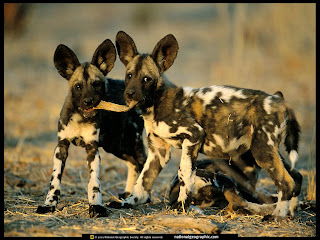Physical Characteristics
The African wild dog is long-legged, with massive jaws and very large, erect batlike ears. Although it resembles some domestic dogs, it differs in that it has four toes on each foot instead of five.
The Latin name for the African wild dog means “painted wolf,” which aptly describes the colorful coat of dark brown, black and yellow patches. Wild dogs have bushy tails with white tips that may serve as a flag to keep the pack in contact while hunting
Habitat
Wild dogs live mostly in arid zones and in the savanna. They also are found in woodland and montane habitats where their prey lives.
Behavior
Wild dogs live in packs of six to 20. If the pack numbers fall below six, hunting efficiency is eroded. The dogs have a peculiar rather playful ceremony that bonds them for a common purpose and initiates each hunt. They start circulating among the other pack members, vocalizing and touching until they get excited and are ready to hunt. They start the hunt in an organized, cooperative manner. When prey is targeted, some of the dogs run close to the animal, while others follow behind, taking over when the leader tired. They can run long distances, at speeds up to about 35 miles per hour.
Of the large carnivores, wild dogs are the most efficient hunters – targeted prey rarely escapes. They tear the flesh until the animal falls, consuming even if it is still alive. This behavior may prejudice people against them, although in reality it may be no worse than the prolonged kills of other carnivores. Apart from its undeniable bloodiness, the remarkable aspect of the their hunting is the complete lack of aggression toward each other. Wild dogs have a social hierarchy but unlike many other social animals, there is little obvious intimidation. They have elaborate greeting rituals, accompanied by twittering and whining. Their large range of vocalizations includes a short bark of alarm, a rallying howl and a bell-like contact call that can be heard over long distances.
Diet
They usually hunt in the early morning and again in late evening, prettying on gazelles and other antelopes, warthogs, wildebeests calves and rat and birds. They may raid domestic stock, but as wild dogs seldom stay in one place for long, this damage is not extensive
Caring for the Young
A nuclear pack of about six dogs usually consists of one dominant breeding pair and several nonbreeding adult male helpers. Occasionally another female in the pack forms a subordinate breeding pair with one of the other males. A breeding female gives birth about once a year, with litters averaging about 10 pups, thought as many as 19 have been recorded. They pups are born in a shelter of thick bush or grass, or in a hole. Usually twice as many males are born. Unlike many other species, the female offspring leave the natal group when they reach maturity, not the males.
The hunting members of the pack return to the den where they regurgitate meat for the nursing female and pups. Although litters are very large, very few pups survive. Sometimes the dens are flooded, or the pups die from exposure or disease. When pack numbers are reduced, hunting is not as efficient and adults may not bring back sufficient food for the pups. The entire pack is involved in the welfare of the pups; both males and females babysit the young and provide food for them.
Predators
Throughout Africa wild dogs have been shot and poisoned by farmers, hunters and, at one time, by rangers who considered them as bloodthirsty raiders of livestocks and dispersers of wild herds. As the numbers of these wild dogs dwindle, they become more mysterious, elusive and enigmatic, reappearing suddenly in places they have not inhabited for months and then vanishing again a few days later. Even though protected in parks and reserves, wild dog populations have declined to the point that packs may no longer be viable. In some areas they are close to extinction.
Did you know?
- No two wild dogs are marked exactly the same, making it easy to identify different individuals. Why such a pattern should develop, and how it serves the hunting dog, has long intrigued scientists.
- Wild dogs are usually on the move over a very large range, covering for example, some 900 square miles in the Serengeti. After a litter is born, however, they will limit their travelling and hunting to areas closer to the den.













